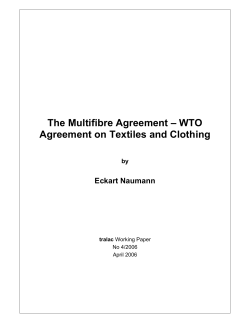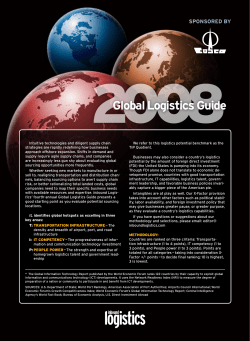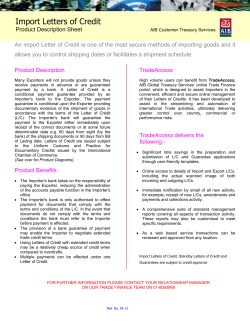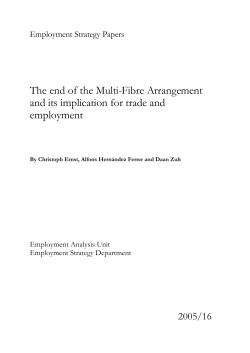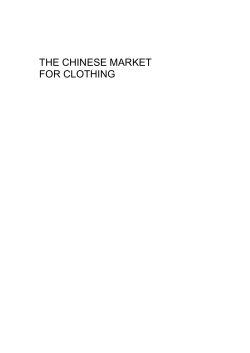
Document 41028
Overseas Development Institute"^ 10-11 Percy Street London W1P OJB Tel: 01-637 3622 Briefing Paper THE T E X T I L E T R A D E , DEVELOPING COUNTRIES AND T H E MULTI-FIBRE A G R E E M E N T Introduction The current GATT Multi-Fibre Agreement (MFA) which entered into force on 1 January 1974 is due to expire in December 1977. The parties to the agreement are currently defining their views on the desirabihty of renewal, renegotiation or non-renewal prior to a review of the M F A by GATT. The review will take place this autumn and a decision in principle on the future of the M F A is likely to be agreed before the New Year. The outcome could be of considerable significance to less developed countries (Idcs) although textile trade between developed countries (dcs) and Idcs is only one part of the total and not necessarily the most important. Before embarking on an analysis of the textile trade it is wise to stress that the subject is extremely complex. There is a considerable variety of production processes, themselves changing, stages of production (fibres, yarns, fabrics, finishing, knitting, etc), as well as a multiplicity of end products. Of the influences acting upon the industry, international trade is only one among many, including technical change, changing patterns and levels of domestic demand, and ownership structures. Because of the complex terminology a glossary is attached. The paper will proceed by looking at global trends in trade and production with the specific objective of identifying the role of Idcs. Then the MFA restrictions are summarised. The British textile industry is analysed briefly because its problems are intrinsically important and are a clue to possible negodating positions at the M F A talks. All the major negotiating interests and Hkely issues are then evaluated. Trends in production and trade Before dealing with the institutional arrangements, it is necessary to consider the economic situation which produced them. Although, as an interconnected system, the textile industry does not lend itself easily to partial analysis, the major components of change can be idenfified as follows: (1) There has been a shift from cotton-based products to man-made fibres (non-synthetic, eg rayon, based on natural cellulose; synthetics, eg nylon and polyester based largely on petrochemicals). In 1939, cotton accounted for 80% of total world textOe fibre consumption by weight, whereas by 1973 it accounted for only 48% (and man-made fibres 42%). Recent changes in relative prices do not suggest strong pressures for a reverse substitution. U K wholesale price indices for man-made fibres registered 100.0 in 1966, 100.0 in 1972 and 151.4 in 1975 (the increase being essentially a result of oO price increases). For raw cotton the index registered 100.0, 131.6 and 222.3. There is, however, some evidence of a short-term check to the encroachment on natural fibres' share of fibre consumption in Britain and of a fashion change back to cotton (jeans, faded denims). (2) A second shift has been that from woven to knitted textiles. In Britain over the decade 1966—76, production of knitted fabrics more than doubled in quantity terms to about 700m square metres, with particularly rapid growth for weft knitting. Woven cotton and woollen fabrics over this period suffered a cut in production by 50% to about 1250m square metres. (3) Overall global production remains concentrated in the (OECD) industrialised world - in 1974, 48.4% of value added in the textiles industry world market and 49.5% in clothing (as against 53.4% and 62.2% in 1963). The major change of the relative shares of production has been towards the communist bloc - 32.2% and 37.4% as against 27.8% and 27.8% in 1963. The developing countries as a group remain less important as producers — 19.4% and 13.1% (as against 18.8% and 10%). (4) The global long-term tendency in trade is for developing countries as a group to have a growing share of world exports, and, if clothing and textiles are combined, for the balance of trade to shift in their favour from an overall Idc-dc trade deficit of ^ 1065m in 1960 and $280m in 1970 to a surplus of $2610m in 1974 (Table 1). Moreover, this shift is greater in quantity terms since Idcs generally produce goods of lower unit value. While trade between communist and western (and Idc) countries is presently at a low level, there is a good deal of intra-Comecon specialisation. Russia for example runs an estimated $2 billion deficit on textiles and clothing with its communist neighbours, the largest of any country in the world. The institute is limited by guarantee. (5) It is necessary however to separate out the different experiences of textiles and clothing: (i) developing countries run an overall deficit with the developed countries on textiles, which has widened between 1970 and 1974, from $1130m to $1330m; (ii) the trade surplus for clothing items in favour of Idcs rose from ?850m in 1970 to $3940m in 1974. One factor influencing this has been the migration of capital from industriaUsed countries to those where labour is more readily available and cheaper, for export back to the developed country markets. (6) In particular, developing countries have obtained a relatively small share of the import market of the developed countries for synthetic and man-made fibres, of yams or woven fabrics made from these fibres, and also of knitted fabrics. The developing countries have aclrieved a higher percentage of imports for cotton yarn and woven fabrics and all kinds of clothing (Table 2). (i) As for the import trade in fibres, the Idcs' contribution is negligible (1.6% of imports in 1973). For man-made yams and fabrics there is still only a small Idc stake in world trade (6.0%), thougli their sales increased over twenty-fold in value in six years (196773). Taiwan is by far the largest supplier (40% of Idc exports in 1973) followed by South Korea and Hong Kong (23% and 13% respectively), (ii) For cottons, the developing countries have a much larger, and expanding, but still a minority share in the developed countries' imports oiyam and woven fabrics (32% in total). Britain and the United States take disproportionately more Idc cotton textile imports mainly from India and Hong Kong but for Britain the share is declining, while that of the USA is increasing. The EEC countries, however, buy from mainly non-ldc sources (ie Southern Europe and from within the EEC). (iii) Finally, the Idcs are taking an increasing share of a rapidly growing market for imported clothing products in the United States and Europe. Britain and the USA are among the most liberal importers.from Idcs but in terms of the value of exports from Idcs, Germany has replaced Britain as a market. Of the suppliers. Hong Kong is dominant (36% of the world Idc exports; 73% of Britain's imports) with Taiwan and South Korea growing rapidly. a 'sharp or substantial rise in imports' or a potential rise, prices 'substantially below' those from comparable sources, and 'threat of serious damage' to textile producers in the importing country. The agreement was renegotiated in 1974. The principle of restriction and the criteria for disruption were retained essentially as before. The main principle, as for the L T A , was that of restraint to be determined for a specific source for a specific product. However, coverage was widened to include man-made fibres and wool. This time the permitted growth rate was 6% in volume as against the 15% which the Idcs asked for. There were two major innovations in addition to the greater product coverage: (1) A Surveillance Board (TSB), was set up to arbitrate on disputes and to assess the 'disruption' caused by imports. It has for example been invoked by Pakistan after slow progress in reaching an agreement with the EEC, and against Australia after it imposed controls unilaterally. (2) In order to protect the position of traditionally more liberal importers such as the UK, 'burden-sharing' agreements were to be worked out, notably within the EEC, in order to bring all partner-states to a predefined 'fair share' of imports from a particular source (originally fixed for the UK at 23.5%; Germany, 28.5%; and France 18.5%). For those cases of which Britain was a disproportionate iinporter, eg cotton cloth from India (up to 1974, Britain took two-and-a-half times more than rest of the EEC together), the EEC agreement was to permit over the 1975-77 period virtually zero growth of imports to the UK (0.5%) ranging, in this case, up to 30% (Italy) to conform to the overall 5% criterion for the EEC. On the other hand, Britain would need to import proportionately larger quantities of Korean underclothes, for example (17% growth; with under 3% growth for France, Benelux and Ireland). The compensation from the Idc viewpoint was that existing bilateral restrictions were to be phased out by the end of 1977, and no new ones were to be permitted except under MFA terms. The MFA in practice Over the last two years a substantial number of 'voluntary' restraint agreements under Article 4 of the MFA have been reached, notably by the USA, Scandinavia, and the EEC. The EEC now has restraint agreements with a variety of countries which can be classified as follows by the level of economic development of the textile exporter: Restrictions (1) per capita GNP over $3000 (1974): Japan; The Multi-Fibre Agreement Restrictions on imports from Idcs were first legitimised under GATT with the 1962 Lx)ng Term Agreement (LTA). These restrictions covered cotton textiles and excluded man-made fibres (with under 50% cotton) and cottage industry products. The aim was an 'orderly growth' of textile imports. Subject to a minimum annual growth rate for imports of 5%, import controls could be imposed, or export restrictions agreed, for particular ranges of products from particular sources. The condition was one of 'market' disruption', the criteria being open to the interpretation of the importer, but including (over and above 'dumping') (2) per capita GNP $1000-3000: Yugoslavia, Hong Kong, Singapore; (3) per capita GNP $200-1000: South Korea,Malaysia, Macao, Colombia, Brazil, Egypt, Taiwan; (4) per capita GNP under $200: India, Pakistan. Agreements are likely to flow from negotiations with Rumania, Mexico, Thailand, Hungary and Poland. Taiwan (which is not a member of GATT) suffered unilaterally imposed restrictions. Lom6 signatories were exempted from restrictions. In general, the EEC has been slow in reaching agreements because of its wish to achieve consensus and the need to work out burden-sharing formulae, and this has allegedly created difficulties for European manufacturers because of precautionary stocking of imports. The country-by-country approach to agreements has also led to precautionary stocking from non-traditional sources, in anticipation of future controls. However, under the M F A the EEC does have emergency powers to stop this (Article 3) if it chose to exercise them. M F A restrictions do not comprise the sum of protective devices. Britain, for example, retains restrictions on woven cotton from a substantial number of countries, and on items outside the EEC agreements with India and Pakistan, and of the kind recently imposed on Eastern European woollen suits. These controls must be subsumed in EEC agreements before 31 March 1977. More serious for the EEC are restricfions imposed by Britain on imports from E F T A and Mediterranean associate countries (Spain, Portugal, Greece, Turkey) with which the EEC has Special Relationship Agreements. On top of this are non-tariff barriers (purchasing policies of public bodies, subsidies to industry under the Industry Act), anti-dumping powers, and a comprehensive system of surveillance licensing. Another complexity is that restrictions imposed under the M F A overlap with the GSP; hence some Idcs face complex 'tariff quotas' with a fixed quantity entering duty-free, and a further amount dutiable up to a quota ceiling. Before evaluating the M F A in the present context, a closer look wdU be taken at the problems and policies of the United Kingdom. The British industry and trade In addition to local interest, the British situation is worth reviewing since Britain has traditionally been regarded as one of the more liberal importers (though in per capita terms less so than Sweden or Canada) and more orientated towards developing country supplies (though, less in percentage terms than the USA or Japan). Since EEC accession, however, Britain's position appears to have changed under pressure of events. Prior to 1974 controls were seen essentially as a temporary device imposed reluctantiy to ease a process of structural adjustment in the industry, to help the better parts to survive. Only cotton cloth enjoyed comprehensive protection. Since then Britain has been more to the fore in seeking restrictive poUcies under the M F A , and specifically in resisting quota increases and retaining restraints not admissible under the M F A until the last moment. It is widely beHeved that Britain will demand a more restrictive revision of the M F A , and the British government is under pressure, which it has so far resisted, to act unilaterally against textile and clothing imports. With an estimated textile domestic consumption growth of 0.75% pa there is furthermore a strong dependence on 'burden sharing' devices. A few facts explain the background to this situation. (1) As Table 3 shows, the overall balance of trade on manufactured yams, fabrics and clothing rose from +£52.5m in 1968 to +£134.1m in 1970, and then declined by stages to - £ 2 2 4 . 2 m in 1975 ( - £ 7 4 . 9 m in first quarter of 1976). (2) However, within this overall figure man-fnade fibres showed a fluctuating but generally steady surplus despite growing import penetration, mainly from the USA. Textile yams and fabrics showed a general surplus, but one sharply reduced in 1975, and a deficit in the first half of the 1976: clothing (including knitwear and 'made-up' clothes) represented the most consistent and precipitate decline from near balance in 1970 to a deficit of £239m in 1975, accounting for most of the overall deficit. Industrial textiles and carpets show a substantial surplus. (3) In terms of the origin of the U K imports (Table 4) for textiles, yarns and fabrics, the share of EEC supplies increased from 38.4% to 43.3% from 1966 to 1975, and of E F T A from 9.4% to 21.2%. The deficit on EEC trade (£63m in 1975) was the major negative item on the trade balance. Developing countries' share of textile imports fell from 33.4% to 18.3% of total imports over the decade; India's drastically from 11.9% to 2.8% (a fall in money value, let alone in real or relative terms), and Hong Kong's share from 11.3% to 5.9%. This illustrates the effectiveness, as well as the discriminatory nature, of cotton textile import controls. By contrast Portugal increased its share of the market from 3.1% to 7.5%, and Austria fiom 1.9% to 5.4%. Supplies to the U K were in effect diverted from India, Pakistan and Hong Kong to Europe without benefiting the overall trade balance. The developing countries actually ran a deficit (£17m) on textile trade with Britain in 1975 (though 1976 trends indicate a likely reversal). (4) Clothing imports from Idcs rose from 46.4% of the total to 50.5%, mainly from Korea (zero to 8.3%) and Taiwan (zero to 5.7%) at the expense of Hong Kong (from 44.9% to 32.7%); but even bigger relative gains were registered by E F T A countries (7.2% to 15.2%) notably Portugal (zero to 5.3%). Britain's deficit with Idcs on clothing was £216m in 1975 which accounts for most of Britain's clothing trade deficit. There are however signs of greatly improved British export performance by high value added, high quality clothing in 1976. However, it is wise to remember that we caimot consider these sectors entirely in isolation. Increasing difficulties in the domestic finished products industry, for example, will (at least in the short run) affect fibre producers, a factor which explains the present problems of Courtaulds. Before considering the effect of imports on production it is worth noting that one favourable consequence of Britain's 'openness' to imports is that consumers have a greater choice of cheaper textOe products than ahnost anywhere else in the developed world. This is not devoid of implications for anti-inflation policy. The difficulties of the British industry are normally measured in tangible terms of loss of employment in the industry. It lost 166,000 jobs in the period 1970-75 in textiles and clothing over and above 140,000 in the previous five years. Until recently, however, this did not show up as above-average net unemployment in the affected areas (many of which suffered labour shortage and as a consequence attracted Asian immigrants). There are several reasons for the general decline in employment: (1) productivity raising capital investment and technical progress (such as the 'knitting revolution'). Much of this improvement has been promoted by government and the chemical companies, notably Courtaulds and ICI, which have come to dominate not only fibre production but also much of the textile industry. Given the slow growth of output, the rapid growth of productivity (above the average of British manufacturing industry) has created redundancies; (2) cycUcal fluctuations in aggregate demand both at home and overseas. This has been a serious factor, especially in increasing unemployment and short-time working in the 1974-76 period. Over-reaction at the various stages of the industry to demand changes seems to create a more unstable stock and output cycle than for many other industries; (3) growing 'import penetration'. This concept, while frequently employed, has emotive overtones. Exports are excluded from the arithmetic.-Moreover by focusing on one type of import, the potential production of exports and import substitutes from the resources freed is ignored. Even within the textile and clothing industry it is possible to see the broader ramifications of speciahsation. Imports may well earn Britain foreign exchange through exports of synthetic fibres, dyes, freight charges, and above all textile machinery, which had a trade surplus in 1975 of £147.5m, aknost all on trade with the Third World. In order to offset at least some of the bias implicit in the concept of import penetration, it is set alongside the role of exports in relation to trade and the trade balance (Table 5). It is difficult to separate the relative significance of these factors, but circumstantial evidence suggests that imports are not necessarily the most important. For example, for woollen and worsted goods 40% of the 1966 labour force had been shed by 1975, while trade remained in surplus and 'import penetration' remained very low; the explanation being a combination of labour-saving productivity improvements and a general fall in the demand for woollens. Cotton textiles has also lost 40% of its manpower since 1966. Import penetration has certainly been high in this sector, but a substantial measure of employment deterioration can be attributed primarily to restructuring and the efficiency-raising investment. For 'made-up' clothing there has been a significant rise in 'import penetration' and a decline in the trade balance despite rapid export growth since 1970/71. This probably explains in substantial part the decline in employment in this industry since 1972, which had hitherto been more stable than in textiles. Competition from imports has also carried particular problems in the knitwear goods industry of the East Midlands, as well as the clothing industry per se; the NEDC Industrial Strategy document on knitwear 'bitterly regretted' the high quota levels agreed under the MFA. But it is important to distinguish symptom and cause. According to the NEDC Clothing Industrial Strategy document the industry has 'very low average productivity' (50% of the manufacturing average) — 'low wage levels' — 'low levels of investment' (per capita investment, 20% of manufacturing average) and 'fragmentation'. This could be remedied in part by government-inspired restructuring, towards which £20m has been granted, but NEDC concedes that 'even with the most advanced production methods the cost structure is such that it is not possible to produce garments such as shirts and men's trousers at prices competitive with . . . . i m p o r t s . . . . ' . If this is so, then temporary protection to ease structural changes and encourage investment will not save substantial parts of the industry; the choice is whether or not consumers should pay, permanently, a higher cost for a basic necessity in order to retain these lines of production in Britain. Because of difficulties faced by the industry its representatives, acting through NEDC's, have made a series of demands for tightened protection. Most recently (in a joint memo in mid-October) the CBI and TUC asked for short-term safeguard measures to be used to the fullest extent and long-term measures to tighten the M F A . The government position — so far — is that present levels of protection are more comprehensive than any previously employed and that adequate safeguard clauses already exist to protect threatened interests. These arguments will now be examined in the context of renegotiation. Issues in renegotiation There are four basic options for the MFA negotiations; (1) renewal on present terms, the position broadly favoured by the United States and Western Germany; (2) renegotiation on more liberal terms, the position of Idcs. A demand for complete free trade was incorporated in the Manila Declaration of the 'Group of 77' (though given less emphasis at UNCTAD IV in Nairobi); (3) renewal on more restrictive terms, as demanded by the European textile industry (through its federation, COMITEXTIL, and at national level); (4) non-renewal, a Ukely outcome if there is a failure to reconcile the groups favouring (2) and (3). This would in practice mean a reversion to nationally imposed quotas. The developing countries, on a general level, argue that the principle of trade restrictions is discriminatory against them — since this is one of the few areas of international trade where they have achieved some degree of success and have a demonstrable comparable advantage in the more unskilled-labour-intensive processes. They argue (and these arguments would probably be accepted in Germany, Sweden or Holland) that such liberalisation would also favour the developed countries as their labour moves into high productivity and high wage employment, and since imports would help restrain prices. Moreover, they argue that any dislocation caused by structural adjustment could, with proper planning and retraining, be eased on the Swedish model. Any abuses such as dumping could be dealt with by existing anti-dumping measures; and there are also emergency safeguard measures under GATT (Article 19), which may be strengthened in the present Tokyo round (these do not at present apply against imports from a particular source). The developing countries are likely to put their demands in the context of UNCTAD, the Paris 'North-South dialogue' * and the whole multilateral tariff bargaining process. The Idcs are likely to seek: (1) a higher rate of growth of permitted imports than 6%; (2) commitment to a phasing out of controls; and (3) concessions on points of interpretation, regarding access and definitions of 'disruption', and the workings of the Textile Surveillance Board. However, their bargaining power is likely to be diminished by the threat of a return to the system of national restrictive policies; by the political weakness of the three leading and relatively high income 'third world' textile exporters - Hong Kong (a colony), Taiwan (a non-member of GATT), or, like South Korea, of questioned political legitimacy; and by the existing preferential treatment accorded to Lome countries, which divides the Group of 77. The developed countries separately or collectively have some specific demands which they are likely to press for. In addition to a general preference for a lower import growth rate and a longer time horizon for controls the points are: (1) A recession clause in the MFA. Several developed countries argue that the 6% import growth figure is unreahstic for a period of slack in consumption and was based on 1973 conditions, now changed considerably. Moreover, it is claimed that high levels of import penetration in a recession tend to have an irreversible 'ratchet' effect by estabUshing a permanent 'base' for these imports for the following upswing. This would be met by a clause which cut import growth rates for recession periods. However, the problems are considerable. How could a 'recession' be defined? How could it be possible to prevent abuse and escalating competitive retaliation using the same recession as a justification (eg against British wool and artificial fibres)? How would the mechanism be made reversible for a boom period, especially if the overall growth figure is to be maintained? (2) Quota globalisation to meet cumulative disruption. Most developed countries are concerned that despite substantial country and product coverage there are several significant uncontrolled sources of import supply which disrupt orderly market growth, notably: — Lome producers (Ivory Coast, Sudan and others are building up textile capacity); — small unrestrained sources, in Latin America, Asia and Eastern Europe; — sources which have a Special Relationship Agreement with the EEC; notably Greece, Turkey, Spain and Portugal; — other developed countries (the EEC, USA); — indirect trade through the EEC (where the EEC does not use its powers under the MFA). These unregulated sources of supply present a particular * ODI produced Briefing Papers on UNCTAD and the Paiis 'North-South' Conference earlier this year. problem since the EEC would find it politically very difficult to impose restraints on Lome countries or on Special Relationship Agreement cases, and they are virtually inconceivable against the USA or by EEC members against others. Were the overall quotas to apply only to existing restrained imports plus some small but growing suppliers (which would somewhat diminish the value of the exercise), there would still be problems of allocating quotas within the global figures. If within the global figures there were a freefor-all, 'super-competitive' suppliers like Hong Kong would probably eliminate other competition. In recognition of this problem, the EEC has (in GSP discussions as well as in this context) begun to discuss the possibilities of discriminating against these sources in favour of countries like India and Pakistan. Whatever formulae were devised, in practice 'globalisation' would require a complex system of management of bilateral arrangements within global figures (comparable to the use of 'butoirs' (quotas) within GSPs). It would also require a reconsideration of burden sharing arrangements within Europe which are presently based on import shares from a particular source. (3) Sensitive products - import penetration. A t present, the 6% growth requirement applies in principle to all textile products and to all sources (unless specific burden sharing agreements can be negotiated, or special terms for a particular sub-product). Some countries are concerned that this formula works to the detriment of countries and industries which already suffer a high degree of 'import penetration', since import growth rates substantially greater than consumption pose the threat of aU growth of consumption going to imports. They wish to make the restraint agreements more selective on the American model to give greater protection to industries under greatest 'threat' from imports. We have seen in the case of the United Kingdom how the argument about 'import penetration' has gathered considerable momentum. Unfortunately the concept defies all economic logic implicit in the concept of specialisation. Growing import penetration could well be compatible with growing export competitiveness as a result of specialisation within a particular product category (or even of the same product, where quality, style, and other taste factors are involved). In the case of Britain there is evidence that this has happened within the category of woollen and worsted yarns and fabrics; and in others (eg continuous filament yarn) a large and growing import penetration may well still be accompanied by a trade surplus. To seek to freeze or control this changing pattern of specialisation on the basis of an arbitrary level of 'import penetration', defined at an arbitrary level of statistical disaggregation, for a particular point of time, would be to reduce considerably the role for trade in promoting specialisation (while nonetheless retaining unlimited opportunities for domestically induced structural change deriving from technical progress and changes of tastes). Not only does this diminish the gains from specialisation in general, but would obUge the developing countries to turn increasingly to less protected products, for which they may have an absolute cost advantage (eg synthetic fibre manufacture) but which are a negation of their comparative advantage (which probably lies in labour-intensive clothing manufacture). The Glossary of terms developing countries and developed country consumers might well regard this as retrograde, though it has precedents in the whole M F A philosophy and specifically in the 1962 version which restrained cotton textiles but not synthetics. COMITEXTIL: Committee of European Textile Manufacturers. GSP: Generalised System of Preferences. Conclusion The M F A is likely to be renewed in broadly its present form. A fundamental shift from trade regulation to free trade is inconceivable. A major tightening of the terms is also difficult to envisage. In any event there will be serious problems for the British government. On one hand it is under strong domestic pressure to obtain tighter restrictions and on the other already under attack because of its negative attitude to the demands of the Idcs as part of their 'New International Economic Order', and because of expectations which it has created that it will act as a generally liberalising, not a protectionist influence within the EEC. Knitwear: garment knitted straight from thread, omitting weaving stage. Lome countries: signatories to the Lome Convention of 1975 between the EEC and 46 developing countries.* Manila Declaration: document prepared by Third Ministerial Meeting of the Group of 77, Manila, January 1976. NEDC: National Economic Development Council. Tokyo Round: the present round of multilateral trade negotiations in Geneva. Woven cloth: fabric prepared by weaving thread. Yarn: spun thread prepared for knitting or weaving. November 1976 * See ODI Briefing Paper on Lome, 1975. Table 1. dcs (OECD) Idcs Global trade balances in textiles and clothing (Sm) TextOes 1970 Clothing All products Textiles 1974 Clothing with Idcs +1130 -850 +280 +1330 -3940 ^2610 with Comecon +160 -30 +130 +530 -425 +105 with all sources + 1290 -880 +410 +1860 -4365 -2505 with dcs -1130 850 -280 -1330 3940 2616 -90 +25 -65 -230 55 -175 -1220 +875 -345 -1560 +3995 +2435 with Comecon with all sources Source: ComitextilBulletin 76/2. All products Table 2. Value and share of developing countries' imports in OECD countries (Sm) Developed (OECD) USA France W Germany UK Cotton yarn and woven fabrics 1967 262.1 (25.7%) 84.2 (52.7%) 2.6 (5.4%) 6.7 (8.4%) 84.5 (48.0%) 1970 367.8 (28.6%) 89.5 (48.8%) 12.1 (15.0%) 30.6 (18.9%) 74.5 (48.0%) 1973 872.5 (32.0%) 198.3 (60.5%) 34.8 (13.1%) 72.3 (19.2%) 121.1 (41.5%) Man-made yarn and woven fabrics 1967 14.4 (1.6%) 4.5 (4.7%) 0.2 (-) 0.9 (0.4%) 2.2 (2.0%) 1970 58.4 (2.5%) 12.4 (5.7%) 2.1 (1.0%) 4.0 (1.0%) 8.9 (4.5%) 1973 301.2 (6.0%) 23.6 (5.7%) 10.4 (3.1%) 27.8 (3.1%) 50.6 (10.3%) Clothing 1967 576.2 (23.9%) 261.4 (43.3%) 2.6 (2.0%) 83.6 (26.3%) 100.5 (45.5%) 1970 1267.7 (26.8%) 640.8 (56.2%) 17.5 (6.9%) 199.7 (20.8%) 134.5 (42.5%) 1973 3729.7 (36.2%) 1500.7 (69.2%) 91.6 (15.6%) 710.5 (27.9%) 414.2 (50.7%) 1 2 3 4 Idcs include Yugoslavia. Cotton yarn and woven fabrics, Standard International Trade Classification (SITC) 6513, 6514, 652. Man-made yam and woven fabrics, SITC 6516, 6517, 6535, 6536. Clothing, SITC 841, 842. Source: OECD, Trade Series C, 1973, Vol II. Table 3. British textiles trade balance (£m current prices) 1968 1970 1972 1974 1975 1976 (1st quarter) Textile yarns, fabrics etc(Div 65) Clothing (Div 84) (78,1 +140.4 +75.7 +57.6 +15.4 -9.3 25.6 6.3 -74.5 -172.4 -239.6 -84.2 Source: Trade ami Industry, 30 July 1976. Table 4. Source of British imports Textiles (SITC 65) 1966 Clothing (SITC 84) 1975 1966 1975 £m % £m % £m % £m % EEC of which W Germany Eire 61 (38.4) 296 (43.3) 21 (30.4) 123 (24.4) 10 11 ( 6.3) ( 6.9) 67 63 ( 9.8) ( 9.2) 1 6 ( 1.4) ( 8.7) 10 44 ( 2.0) ( 8.7) EFTA of which Portugal Switzerland 15 ( 9.4) 145 (21.2) 5 ( 7.2) 77 (15.2) 5 6 ( 3.1) ( 3.8) 51 43 ( 7.5) ( 6.3) — 2 ( 2.9) 27 9 ( 5.3) ( 1.8) 4 ( 2.5) 13 ( 1.9) 1 ( 1.4) 17 ( 3.4) USA 11 ( 6.9) 68 (10.0) 2 ( 2.9) 7 ( 1.4) Japan 4 ( 2.5) , 12 ( 1.7) 2 ( 2.9) 5 ( 1-0) 53 (33.3) 125 (18.3) 32 (46.4) 255 (50.5) 19 18 (11.9) (11.3) 19 40 ( 2.8) ( 5.9) 31 11 165 32 29 ( 2.2) (32.7) ( 6.3) ( 5.7) Comecon Developing Countries of which India Hong Kong S Korea Taiwan World - — — — - - - 159 683 69 (44.9) 505 Source: NEDC, Textile Trends, 1966-75. Table 5. UK import penetration and exports Man-made Fibres Yarn of which cotton continuous filament woollen yarn Fabrics of which cotton cloth woollen cloth End products^ of which made up clothing^ knitted garments* carpets Import Penetration' Exports as % of Manufacturers' Sales 1966 1975 1966 1975 1966 1975 15.7 31.4 +9.0 +55.8 4.8 22.3 _ — +44.2 +31.6 7.1 8.9 0.7 26.1 35.0 3.8 2.5 21.6 5.6 9.3 35.6 7.8 — — — — - - — +34.0 27.8 45.1 (1974) 39.5 10.9 53.4 12.9 16.0 27.1 8.0 21.3 (1974) — 6.2 9.5 9.0 18.8 (1974) 27.8 (1974) 13.1 (1974) 4.7 7.0 12.1 20.6 28.4 _ 9.7(1974) 19.1 (1974) 25.3 (1974) Trade Balance (£m) - -76.1 - -9.7 -194.3 -9.9 -170.0 -7.2 -76.7 +5.6 +45.4 imports as % of home consumption (ie production plus imports less exports). ^ import penetration and exports' relation to sales measured in current money values; otherwise quantities for items except end products. ^ within this substantial sector it is worth noting that the import penetration (1975) for particular items is blouses (55%), men's and boys' trousers (50%), men's and boys' coats (53%), woven shirts (62%). '* ditto for knitted shirts (68%), knitted dresses (24%), knitted outwear(28%). Source: NEDC, Textile Trends, 1966-75.
© Copyright 2025





